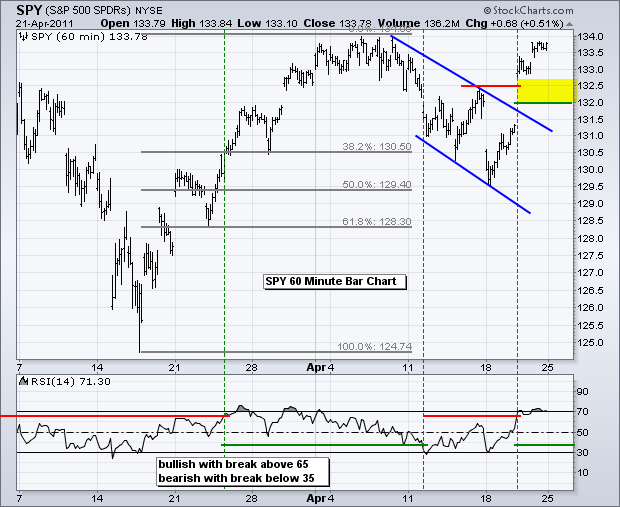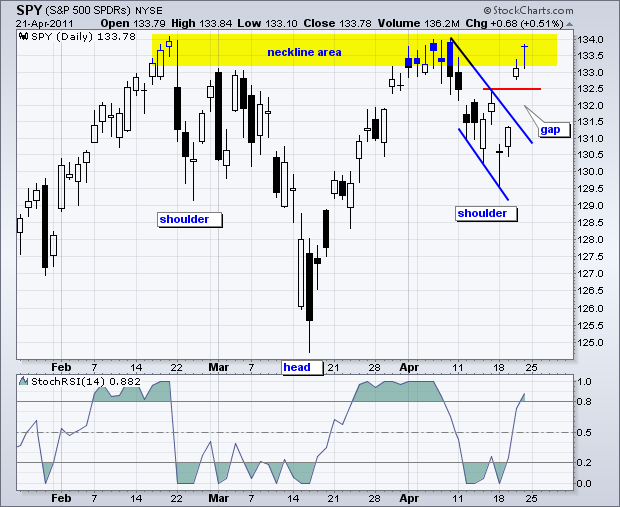On the daily chart, the S&P 500 ETF (SPY) is tracing out a clear inverse head-and-shoulders pattern over the last 2-3 months. The shoulders feature equal lows around 129.5 and the highs in the 133-134 area mark neckline resistance. Notice how the right shoulder also formed a falling flag and last week's surge broke flag resistance with a big gap. Even though the ETF is short-term overbought after a 2.5% advance in three days, the gap and breakout are holding.
On the 60-minute chart, the gap zone extends from 131.5 to 132.9, but I would be inclined to set short-term support a little higher. This is in essence the failure-watch level. The yellow area marks a support zone around 132-132.5, which was the prior resistance zone. A move below 132 would put SPY back into the gap zone and increase the chances of a failure at resistance. RSI surged above 65 to confirm the breakout in SPY. Bull range support is now set at 35.

Key Economic Reports/Events:
Mon - Apr 25 - 10:00 - New Home Sales
Tue - Apr 26 - 09:00 - Case-Shiller Housing Index
Tue - Apr 26 - 10:00 - Consumer Confidence
Wed - Apr 27 - 07:00 - MBA Mortgage Index
Wed - Apr 27 - 08:30 - Durable Orders
Wed - Apr 27 - 10:30 - Oil Inventories
Wed - Apr 27 - 12:30 - FOMC Rate Decision
Thu - Apr 28 - 08:30 - GDP
Thu - Apr 28 - 08:30 - Jobless Claims
Thu - Apr 28 - 10:00 - Pending Home Sales
Fri - Apr 29 - 08:30 - Personal Income and Spending
Fri - Apr 29 - 09:45 - Chicago PMI
Fri - Apr 29 - 09:55 - Michigan Sentiment
Charts of Interest: Tuesday and Thursday in separate post.
-----------------------------------------------------------------------------
This commentary and charts-of-interest are designed to stimulate thinking. This analysis is not a recommendation to buy, sell, hold or sell short any security (stock ETF or otherwise). We all need to think for ourselves when it comes to trading our own accounts. First, it is the only way to really learn. Second, we are the only ones responsible for our decisions. Think of these charts as food for further analysis. Before making a trade, it is important to have a plan. Plan the trade and trade the plan. Among other things, this includes setting a trigger level, a target area and a stop-loss level. It is also important to plan for three possible price movements: advance, decline or sideways. Have a plan for all three scenarios BEFORE making the trade. Consider possible holding times. And finally, look at overall market conditions and sector/industry performance.

About the author:
Arthur Hill, CMT, is the Chief Technical Strategist at TrendInvestorPro.com. Focusing predominantly on US equities and ETFs, his systematic approach of identifying trend, finding signals within the trend, and setting key price levels has made him an esteemed market technician. Arthur has written articles for numerous financial publications including Barrons and Stocks & Commodities Magazine. In addition to his Chartered Market Technician (CMT) designation, he holds an MBA from the Cass Business School at City University in London.
Learn More






